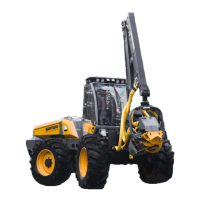The minimum space between the harvester and
power lines with voltage must be in accordance
with the enclosed illustration, in which the danger
zone is darkened.
Low-voltage power lines (230/400V) can be
distinguished from high-voltage lines (over 1 kV)
by the smaller insulators and the fact that there
are usually 4 low-voltage lines. In case the height
or voltage of the power line is difficult to estimate,
the Electric Company shall be consulted
In case the height or voltage of the power line
is difficult to estimate, the Electric Company shall
be consulted.
In case of accident
If there is an accident despite all precautions, keep
calm and consider carefully what to do. First try to
reverse the harvester away from the power line.
If there are other people near, ask them to check
that the harvester is not stuck in the line. If the
harvester is just leaning against the lines, try to
drive it away from them. Follow the advice from
the people nearby. Due to their own safety, they
shall stay a minimum of 20 metres away from the
harvester touching the power line.
If the harvester cannot be driven off, and you have
to leave the machine, jump down with your feet
together in order not to touch the harvester and
the ground simultaneously. Do not make yourself a
conductor through which electricity can pass; the
real danger lies in touching the harvester and the
ground simultaneously.
Get away from the harvester jumping either with
your feet together, or with only one foot on the
ground at a time. Otherwise the electric field on
the ground may create a fatal electric current
between your legs. You will be safe at a distance
of 20 metres from the harvester. Beware of broken
power lines lying on the ground.
A harvester touching a power line may catch fire.
Leave the harvester immediately if smoke starts
coming from the tyres.
Make sure the harvester will be guarded at a safe
2m
2m
5 m
4 m 4 m
400/230
1 - 45 kV
110 - 400 kV
400 kV 220 kV 110 kV
Ca. 5 m
Ca. 6 -8m
Ca. 4 m
(On side 5 m)
(On side 3 m)
(On side 2 m)

